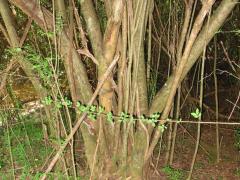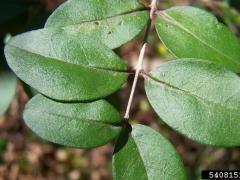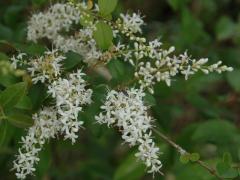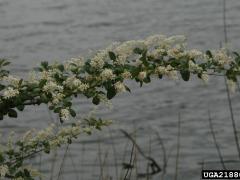Invasive Species: Ligustrum sinense, Chinese Privet
Chinese privet invades and damages native ecosystems. Privet’s dense growth shades out native plants, especially in the forest understories and along riparian corridors. Chinese privet is a semi-evergreen shrub or small tree that grows to 20 ft (6.1 m) in height. Trunks usually occur as multiple stems with many long, leafy branches. Leaves are opposite, oval, pubescent on the underside of the midvein, and less than 2 in. (5 cm) long. Flowering occurs in late spring, when small, white flowers develop at the ends of branches in clusters that are 2 to 3 in. (5 to 7.6 cm) long. Fruit are oval, fleshy, and less than 0.5 in. (1.3 cm) long. They ripen to dark purple to black and persist into winter. Several privet species occur, and distinguishing among them can be difficult. Chinese privet can tolerate a wide range of conditions. Plants form dense thickets, invading fields, fencerows, roadsides, forest understories, and riparian sites. They can shade out and exclude native understory species, perhaps even reducing tree recruitment. Native to Europe and Asia, Chinese privet was introduced in the United States in 1852 as an ornamental plant. It is commonly used as an ornamental shrub and for hedgerows.
What are invasive species, and why should we be concerned about them?
Taxonomy: Scientific and Common Names for This Species
Scrophulariales > Oleaceae > Ligustrum sinense Lour.
Synonym(s): common Chinese privet, common privet
Ligustrum sinense – USDA PLANTS Profile
Distribution Maps
Chinese privet – The reported distribution of this invasive species across the United States (Source: Invasive Plant Atlas of the United States)
Up-to-the-minute distribution maps and why they are important
Reporting This Invasive Species
What is the best way to report the occurrence of an invasive species?
How to report an invasive species sighting to EDDMapS – Early Detection & Distribution Mapping System
EDDMapS – Report an invasive species to EDDMapS.
County Extension Offices – Find your county Extension office on this map provided by USDA.
How to Identify
This invasive species can be identified by looking for the characteristics described in the paragraphs that follow.
Shrub
Non-native privet is a semi-evergreen shrub or small tree that grows to 20 ft (6.1 m) in height. Trunks usually occur as multiple stems with many long, leafy branches.
 |
 |
| David J. Moorhead, University of Georgia, bugwood.org | Nancy Loewenstein, Auburn University, bugwood.org |
Foliage
Leaves are opposite, oblong, 1 to 2.4 in. (2.5 to 6 cm) long, and 0.2 to 0.6 in. (0.5 to 1.5 cm) wide. Foliage can be pubescent along the underside of the midvein.
 |
 |
| Karan A. Rawlins, University of Georgia, bugwood.org | Karan A. Rawlins, University of Georgia, bugwood.org |
Flower
Flowering occurs from April to June, when panicles of white to cream flowers develop in terminal and upper axillary clusters. Pollen can cause an allergic reaction in some people.
 |
 |
| Chris Evans, River to River CWMA, bugwood.org | Chris Evans, River to River CWMA, bugwood.org |
Fruit
The abundant fruits are spherical and 0.3 to 0.5 in. (1 to 1.3 cm) long. Fruit begins green, ripens to dark purple to black, and persists into winter. Birds and other wildlife eat the fruit and disperse the seeds. Seed soil viability is about one year. The plant also colonizes by root sprouts.
 |
 |
| James H. Miller, USDA Forest Service, bugwood.org | Charles T. Bryson, USDA Agricultural Research Service, bugwood.org |
Native Species That Resemble Chinese Privet
– Images at invasive.org
| bugwood.org | bugwood.org |
– Images at invasive
| bugwood.org | bugwood.org |
Additional Images for Chinese Privet
Chinese privet – Images at invasive.org
Learning Resources for Chinese Privet
Ligustrum sinense Identification Card – U.S. Fish and Wildlife Service
Ligustrum sinense Fact Sheet – U.S. Fish and Wildlife Service
Ligustrum sinense Fact Sheet – UW-Extension Weed Science
Additional Information, Biology, Control and Management Resources
Control and management recommendations vary according to individual circumstances. Location, habitat, weather, and a variety of other conditions are factors that help determine the best treatment choice. To find the safest and most effective treatment for your situation, consult your state’s land-grant institution. If you will use chemicals as part of the control process, always refer to the product label.
United States Land-Grant University System – Find your Land-Grant University’s College of Agriculture, University Cooperative Extension Service, or other related partner on this map provided by USDA.
A Management Guide for Invasive Plants in Southern Forests – USDA Forest Service
A Field Guide for the Identification of Invasive Plants in Southern Forests – USDA Forest Service
Plant Invaders of Mid-Atlantic Natural Areas – National Park Service and U.S. Fish and Wildlife Service
Southeast Exotic Pest Plant Council Invasive Plant Manual – Southeast Exotic Pest Plant Council (SE-EPPC)
Fire Effects Information System – USDA Forest Service
Element Stewardship Abstract – The Nature Conservancy
Invasive Plant Atlas of New England – University of Connecticut
Center for Aquatic and Invasive Plants – University of Florida’s Institute of Food and Agricultural Sciences (IFAS)
